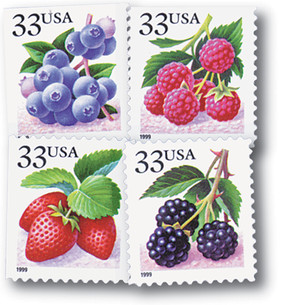
U.S. #3298-3301
1999 33¢ Four Fruit Berries
Flora and Fauna
Issue Date: April 10, 1999
City: Ponchatoula, LA
Quantity: 1,200,000,000
Printed By: Guilford Gravure for Banknote Corporation of America
Printing Method: Photogravure
Perforations: 9 ½ x 10
Color: Multicolored
The Four Fruit Berries stamps were issued April 10 at the Ponchatoula Strawberry Festival in Ponchatoula, Louisiana. The event is the largest free two-day festival in Louisiana.
The stamps were released in three different self-adhesive formats: coils of 100, convertible panes of 20; and folded booklets of 15. The coil version of this issue is the first of a kind for the United States Postal Service. This se-tenant variety features each design adjacent to one another on the backing paper without a space appearing between each stamp. Issues featuring multiple designs have been released as coils by the Postal Service before the Fruit Berries. But prior issues, like the Contemporary Christmas stamps of 1993, were on backing paper with spaces in between the stamps.
Artist Ned Seidler created the Four Fruit Berries stamps. Other stamps illustrated by Seidler include the African Violet stamp of 1993, four Garden Flowers booklets (released from 1993 to 1996), the Peaches and Pear stamps (1995), and American Holly stamp of 1997.
Birth Of Luther Burbank
Luther A. Burbank was born on March 7, 1849, in Lancaster, Massachusetts.
The thirteenth of eighteen children, Burbank spent his childhood on his family farm enjoying his mother’s large garden. He only received a high school education but would go on to become a pioneer in agricultural science.
Following his father’s death, Burbank used his inheritance to buy 17 acres of land near Lundenburg. There he developed the Burbank potato and sold the rights to it for $150. He then used that money to travel to Santa Rosa, California, in 1875. The Burbank potato was later renamed the Russet Burbank potato and became one of the most widely used potatoes for food processing, such as for French fries.
After moving to California, Burbank bought four acres of land and set up a greenhouse, nursery, and experimental fields. He used these fields to experiment with crossbreeding after reading Charles Darwin’s The Variation of Animals and Plants under Domestication. He later expanded his plot by another 18 acres.
In the coming years, Burbank began producing popular plant catalogs, most notably his 1893 “New Creations in Fruits and Flowers.” Around this same time, Burbank met Clarence McDowell Stark, of Stark Bro’s Nurseries & Orchards. At the time, Burbank was running a small seed and nursery business to make ends meet, distracting him from his brilliant work in hybridizing. Stark believed he was wasting his time with the nursery business so he offered him $9,000 for three varieties of fruits.
Burbank also had fans, The Luther Burbank Society, which worked to publish his discoveries and manage his business dealings to help him out financially. Additionally, from 1904 through 1909, the Carnegie Institution gave Burbank several grants to fund his research. Andrew Carnegie was a strong supporter of Burbank.
Click here to read more about some of Burbank’s plants.










